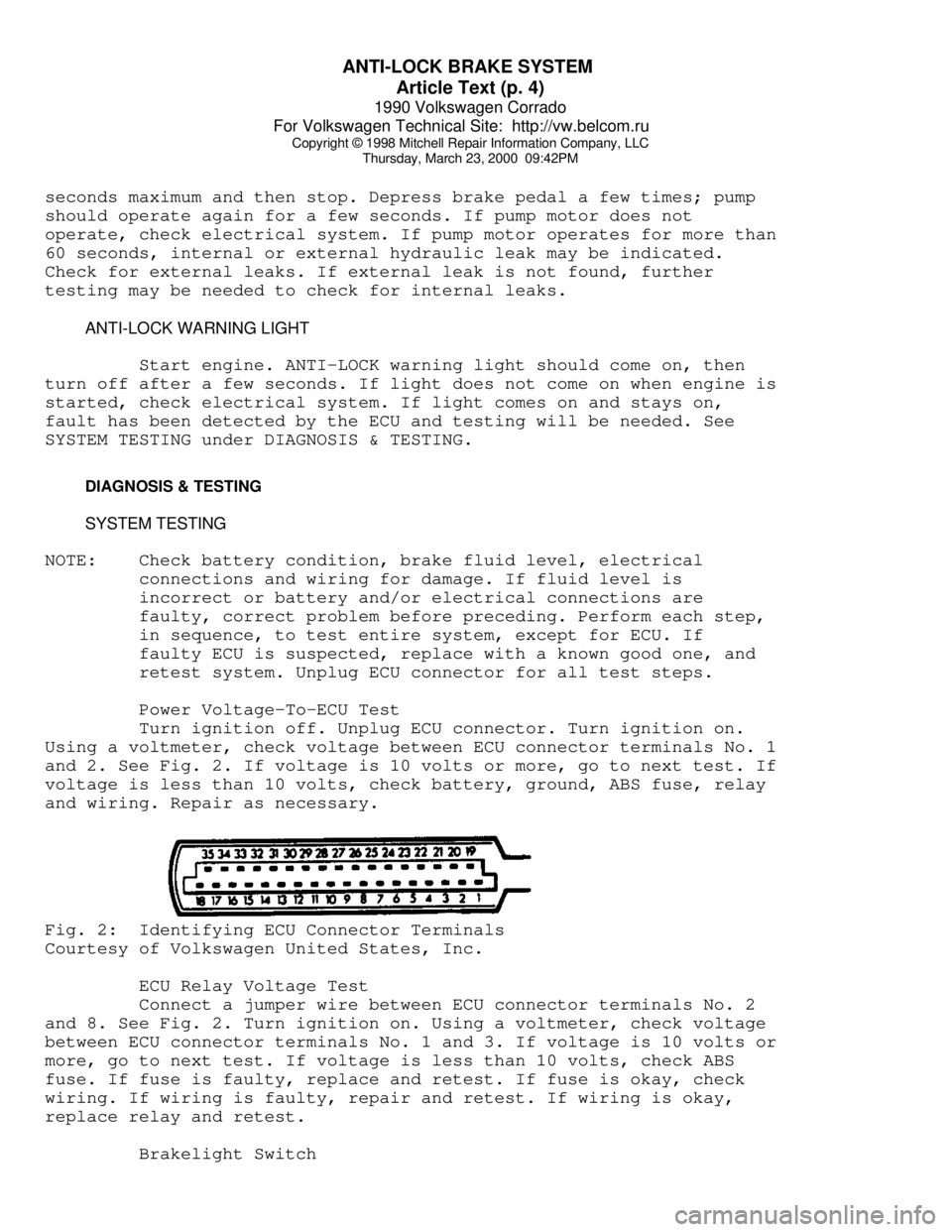1990 VOLKSWAGEN CORRADO engine
[x] Cancel search: enginePage 402 of 906

ALTERNATOR & REGULATOR - BOSCH
Article Text
1990 Volkswagen Corrado
For Volkswagen Technical Site: http://vw.belcom.ru
Copyright © 1998 Mitchell Repair Information Company, LLC
Thursday, March 23, 2000 09:42PM
ARTICLE BEGINNING
1989-92 ELECTRICAL
Alternators & Regulators - Bosch
Cabriolet, Fox, Golf, GTI, Jetta, Jetta GLI, Vanagon
1991 Corrado, Passat & Golf GL
NOTE: Some Golf, GTI, Jetta and Jetta GLI models may use a
Motorola alternator. Please refer to ALTERNATORS - SEV
MOTOROLA article. Vanagon models only use Bosch 90-amp
alternators.
DESCRIPTION
Bosch alternators are conventional 3-phase, self-rectifying
type alternators. Bosch 65 through 75-amp alternators use 3 positive
and 3 negative diodes connected to stator windings to rectify current.
Bosch 90-amp alternators use 14 diodes.
All alternators use 3 exciter diodes connected to stator
windings. These diodes turn off the alternator indicator light and
supply power to the voltage regulator while the engine is running.
Bosch regulators are transistorized and integral with alternator.
BELT TENSION ADJUSTMENT
BELT TENSION SPECIFICATIONSÄÄÄÄÄÄÄÄÄÄÄÄÄÄÄÄÄÄÄÄÄÄÄÄÄÄÄÄÄÄÄÄÄÄÄÄÄÄÄÄÄÄÄÄÄÄÄÄÄÄÄÄÄÄÄApplication (1) Deflection In. (mm)
New Belt ................................... 5/64 (2)
Used Belt ................................. 13/64 (5)
(1) - Deflection is with 22 lbs. (10 kg) pressure
applied midway on longest belt run.
ÄÄÄÄÄÄÄÄÄÄÄÄÄÄÄÄÄÄÄÄÄÄÄÄÄÄÄÄÄÄÄÄÄÄÄÄÄÄÄÄÄÄÄÄÄÄÄÄÄÄÄÄÄÄÄ TESTING (ON-VEHICLE)
WIRING CONTINUITY TEST
1) Connect a voltmeter between alternator "B+" terminal and
ground. Voltmeter should indicate battery voltage. If not, check
wiring between alternator and battery.
2) Turn ignition on and ensure alternator indicator light
comes on. If light does not come on, check wiring between alternator
and warning light, including indicator bulb.
OUTPUT TEST
1) Ensure connections at battery, alternator, and starter
Page 403 of 906

ALTERNATOR & REGULATOR - BOSCH
Article Text (p. 2)
1990 Volkswagen Corrado
For Volkswagen Technical Site: http://vw.belcom.ru
Copyright © 1998 Mitchell Repair Information Company, LLC
Thursday, March 23, 2000 09:42PM
(most vehicles) are clean and tight. Ensure alternator, engine and
body are properly grounded. Ensure alternator drive belt is tight and
in good condition.
2) Connect ammeter following manufacturer's instructions.
Connect voltmeter leads to battery terminals. Adjust carbon pile on
tester until voltmeter reads 13.5 volts. Alternator output should be
28-35 amps.
3) Repeat process at 1000 RPM. Alternator output should be
75-85 amps. Repeat test at 2000 RPM. Alternator output should be 89
amps. If alternator output is low, remove alternator for testing and
repairs.
4) Start engine and run at 3000 RPM. Adjust carbon pile on
tester to obtain maximum alternator output. Do not allow voltage to go
below 12.6 volts.
5) Alternator output should equal alternator rated output,
minus 16-20 amps. If reading is 16-20 amps below alternator rating,
replace regulator and retest. If output is still low, repair or
replace alternator.
REGULATOR CONTROL VOLTAGE TEST
1) Connect ammeter following manufacturer's instructions.
Connect voltmeter leads to battery terminals. Start engine and run at
3000 RPM.
2) Run engine until voltage stops rising. Voltage should be
13.5-14.5 volts. If reading is incorrect, remove regulator and ensure
brushes are longer than 7/32" (6 mm). Replace if necessary.
3) If brushes are okay and regulator fails to keep voltage
within specified limits, replace regulator and retest. If voltage is
still incorrect, repair or replace alternator.
BENCH TESTING
DIODE ASSEMBLY
1) Place ohmmeter on x 100 scale. Connect ohmmeter leads
across "B+" terminal and 3 stator terminals one at a time. Reverse
leads. Ohmmeter should indicate continuity in one direction only.
2) Connect ohmmeter leads across negative plate and 3 stator
terminals one at a time. See Fig. 1. Reverse leads. Ohmmeter should
indicate continuity in one direction only.
3) Connect ohmmeter leads across "D+" terminal and 3 stator
terminals one at a time. Reverse leads. Ohmmeter should indicate
continuity in one direction only. Replace diode assembly if defective.
Page 412 of 906

ANTI-LOCK BRAKE SYSTEM
Article Text (p. 4)
1990 Volkswagen Corrado
For Volkswagen Technical Site: http://vw.belcom.ru
Copyright © 1998 Mitchell Repair Information Company, LLC
Thursday, March 23, 2000 09:42PM
seconds maximum and then stop. Depress brake pedal a few times; pump
should operate again for a few seconds. If pump motor does not
operate, check electrical system. If pump motor operates for more than
60 seconds, internal or external hydraulic leak may be indicated.
Check for external leaks. If external leak is not found, further
testing may be needed to check for internal leaks.
ANTI-LOCK WARNING LIGHT
Start engine. ANTI-LOCK warning light should come on, then
turn off after a few seconds. If light does not come on when engine is
started, check electrical system. If light comes on and stays on,
fault has been detected by the ECU and testing will be needed. See
SYSTEM TESTING under DIAGNOSIS & TESTING.
DIAGNOSIS & TESTING
SYSTEM TESTING
NOTE: Check battery condition, brake fluid level, electrical
connections and wiring for damage. If fluid level is
incorrect or battery and/or electrical connections are
faulty, correct problem before preceding. Perform each step,
in sequence, to test entire system, except for ECU. If
faulty ECU is suspected, replace with a known good one, and
retest system. Unplug ECU connector for all test steps.
Power Voltage-To-ECU Test
Turn ignition off. Unplug ECU connector. Turn ignition on.
Using a voltmeter, check voltage between ECU connector terminals No. 1
and 2. See Fig. 2. If voltage is 10 volts or more, go to next test. If
voltage is less than 10 volts, check battery, ground, ABS fuse, relay
and wiring. Repair as necessary.Fig. 2: Identifying ECU Connector Terminals
Courtesy of Volkswagen United States, Inc.
ECU Relay Voltage Test
Connect a jumper wire between ECU connector terminals No. 2
and 8. See Fig. 2. Turn ignition on. Using a voltmeter, check voltage
between ECU connector terminals No. 1 and 3. If voltage is 10 volts or
more, go to next test. If voltage is less than 10 volts, check ABS
fuse. If fuse is faulty, replace and retest. If fuse is okay, check
wiring. If wiring is faulty, repair and retest. If wiring is okay,
replace relay and retest.
Brakelight Switch
Page 427 of 906

B - EMISSION APPLICATION
Article Text
1990 Volkswagen Corrado
For Volkswagen Technical Site: http://vw.belcom.ru
Copyright © 1998 Mitchell Repair Information Company, LLC
Thursday, March 23, 2000 09:43PM
ARTICLE BEGINNING
1990 ENGINE EMISSIONS
Emission Control Applications
Cabriolet, Corrado, Fox, Golf, Jetta, Passat, Vanagon
EMISSION CONTROL DEVICE APPLICATIONS
EMISSION CONTROL DEVICE APPLICATIONS TABLEÄÄÄÄÄÄÄÄÄÄÄÄÄÄÄÄÄÄÄÄÄÄÄÄÄÄÄÄÄÄÄÄÄÄÄÄÄÄÄÄÄÄÄÄÄÄÄÄÄÄÄÄÄÄÄÄÄÄÄÄÄÄÄÄÄApplication Devices
Cabriolet 1.8L (CIS-E) PCV, EVAP, TWC, SPK, O2, CEC,
EVAP-PV, EVAP-VC, SPK-CC, VA
Corrado 1.8L (PFI) PCV, EVAP, TWC, O2, CEC,
PCV-HCB, EVAP-PV, EVAP-VC, SPK-CC
Fox 1.8L (CIS-E) PCV, EVAP, TWC, EGR (Calif.), O2,
CEC, EVAP-VC, EVAP-VS, EGR-VA (Calif.),
EGR-TVV (Calif.), SPK-CC, VA
Golf & Jetta
1.8L (CIS-E) PCV, EVAP, TWC, SPK, O2, CEC,
CE, EVAP-VC, EVAP-PV, SPK-CC, VA
2.0L (CIS-E) PCV, EVAP, TWC, EGR, SPK, O2, CEC,
CE, EVAP-VC, EGR-TVV, SPK-CC,
Passat 2.0L CIS-E PCV, EVAP, TWC, EGR (Calif.),
SPK, O2, CEC, CE, EVAP-VC,
EVAP-SV, EGR-TVV, SPK-CC,
Vanagon PFI PCV, EVAP, TWC, EGR, SPK, O2, CEC, EMR,
CE, EVAP-VC, EVAP-PV, SPK-CC, VA, VR
ÄÄÄÄÄÄÄÄÄÄÄÄÄÄÄÄÄÄÄÄÄÄÄÄÄÄÄÄÄÄÄÄÄÄÄÄÄÄÄÄÄÄÄÄÄÄÄÄÄÄÄÄÄÄÄÄÄÄÄÄÄÄÄÄÄ ABBREVIATION DEFINITIONS
CEC - Computerized Engine Control
CE - Check Engine Light
CIS-E - Continuous Injection System-Electronic
EGR - Exhaust Gas Recirculation
EGR-VA - EGR-Vacuum Amplifier
EGR-TS - EGR Temperature Sensor
EGR-TVV - EGR Thermal Vacuum Valve
EVAP - Fuel Evaporation System
EVAP-CS - EVAP Control Solenoid
Page 429 of 906

C - SPECIFICATIONS
Article Text
1990 Volkswagen Corrado
For Volkswagen Technical Site: http://vw.belcom.ru
Copyright © 1998 Mitchell Repair Information Company, LLC
Thursday, March 23, 2000 09:43PM
ARTICLE BEGINNING
1990 ENGINE PERFORMANCE
Volkswagen C - Specifications
All Models
INTRODUCTION
Use this article to quickly find specifications related to
servicing and on-vehicle adjustments. This is a quick-reference
article for when you are familiar with an adjustment procedure and
only need a specification.
BATTERY SPECIFICATIONS TABLE
BATTERY SPECIFICATIONS TABLEÄÄÄÄÄÄÄÄÄÄÄÄÄÄÄÄÄÄÄÄÄÄÄÄÄÄÄÄÄÄÄÄÄÄÄÄÄÄÄÄÄÄÄÄÄÄÄÄÄÄÄÄÄÄÄApplication Amp Hr. Rating
Cabriolet, Fox, Jetta & Jetta GLi
Without A/C .................................... 54
With A/C ....................................... 63
Corrado .......................................... 63
Golf GL/GTI 1.8L, & Vanagon ...................... 63
ÄÄÄÄÄÄÄÄÄÄÄÄÄÄÄÄÄÄÄÄÄÄÄÄÄÄÄÄÄÄÄÄÄÄÄÄÄÄÄÄÄÄÄÄÄÄÄÄÄÄÄÄÄÄÄ FLUID CAPACITIES TABLE
FLUID CAPACITIES TABLE
ÄÄÄÄÄÄÄÄÄÄÄÄÄÄÄÄÄÄÄÄÄÄÄÄÄÄÄÄÄÄÄÄÄÄÄÄÄÄÄÄÄÄÄÄÄÄÄÄÄÄÄÄÄÄÄÄÄÄÄÄÄÄÄÄÄApplication Quantity
Qts. (L)
Auto. Transaxle (Dexron-II) ..................... (1) 3.2 (3.0)
Auto. Transaxle Final Drive (SAE 90/API GL-5)
Except Vanagon ..................................... .8 (.76)
Vanagon ........................................... 1.4 (1.3)
Cooling System (Includes Heater)
Cabriolet ......................................... 5.1 (4.8)
Corrado ........................................... 6.0 (5.5)
Fox ............................................... 6.9 (6.5)
Golf GL/GTI (1.8L) ................................ 7.3 (7.0)
Jetta GLi (2.0L) .................................. 5.1 (4.8)
Jetta ............................................. 5.1 (4.8)
Vanagon ......................................... 18.4 (17.5)
Crankcase (Includes Filter)
Fox ............................................... 3.7 (3.5)
Vanagon ........................................... 4.8 (4.5)
Page 431 of 906

C - SPECIFICATIONS
Article Text (p. 3)
1990 Volkswagen Corrado
For Volkswagen Technical Site: http://vw.belcom.ru
Copyright © 1998 Mitchell Repair Information Company, LLC
Thursday, March 23, 2000 09:43PM
COMPRESSION SPECIFICATIONS TABLE
COMPRESSION SPECIFICATION TABLEÄÄÄÄÄÄÄÄÄÄÄÄÄÄÄÄÄÄÄÄÄÄÄÄÄÄÄÄÄÄÄÄÄÄÄÄÄÄÄÄÄÄÄÄÄÄÄÄÄÄÄÄÄÄÄÄÄÄÄÄÄÄÄÄÄ Compression
Pressure Compression
Application psi (kg/cm
ý) Ratio
Cabriolet ............. 131-174 (9.0-12.0) ............ 8.5:1
Corrado ............... 116-174 (8.0-12.0) ............ 8.0:1
Fox ................... 131-174 (9.0-12.0) ............ 9.0:1
Golf GL/GTI ........... 131-174 (9.0-12.0) ........... 10.0:1
Jetta ................. 131-174 (9.0-12.0) ........... 10.0:1
Jetta GLi ............. 145-190 (10.0-13.0) .......... 10.0:1
Vanagon ............... 145-190 (10.0-13.0) ........... 9.0:1
ÄÄÄÄÄÄÄÄÄÄÄÄÄÄÄÄÄÄÄÄÄÄÄÄÄÄÄÄÄÄÄÄÄÄÄÄÄÄÄÄÄÄÄÄÄÄÄÄÄÄÄÄÄÄÄÄÄÄÄÄÄÄÄÄÄ VALVE CLEARANCE
NOTE: All models are equipped with hydraulic lifters. No
adjustments are required.
NOTE: Right and left sides refer to engine, as viewed from
flywheel.
VALVE ARRANGEMENT
1.8L & 2.0L
Left Side - All Intake
Right Side - All Exhaust
2.1L
Both Banks - E-I-I-E
IGNITION COIL RESISTANCE TABLE
IGNITION COIL RESISTANCE TABLE (1)
ÄÄÄÄÄÄÄÄÄÄÄÄÄÄÄÄÄÄÄÄÄÄÄÄÄÄÄÄÄÄÄÄÄÄÄÄÄÄÄÄÄÄÄÄÄÄÄÄÄÄÄÄÄÄÄÄÄÄÄÄÄÄÄÄÄApplication Primary Secondary
Jetta GLi ................... .60-.70 ............. 6500-8500
All Other Models ............ .52-.76 ............. 2400-3500
(1) - Ohms @ 68
øF (20øC).
ÄÄÄÄÄÄÄÄÄÄÄÄÄÄÄÄÄÄÄÄÄÄÄÄÄÄÄÄÄÄÄÄÄÄÄÄÄÄÄÄÄÄÄÄÄÄÄÄÄÄÄÄÄÄÄÄÄÄÄÄÄÄÄÄÄ HIGH TENSION WIRE RESISTANCE TABLE
Page 434 of 906

C - SPECIFICATIONS
Article Text (p. 6)
1990 Volkswagen Corrado
For Volkswagen Technical Site: http://vw.belcom.ru
Copyright © 1998 Mitchell Repair Information Company, LLC
Thursday, March 23, 2000 09:43PM
Vanagon ...................... 21-25 ................... 3400ÄÄÄÄÄÄÄÄÄÄÄÄÄÄÄÄÄÄÄÄÄÄÄÄÄÄÄÄÄÄÄÄÄÄÄÄÄÄÄÄÄÄÄÄÄÄÄÄÄÄÄÄÄÄÄÄÄÄÄÄÄÄÄÄÄ FUEL PUMP PERFORMANCE
NOTE: Fuel pump performance is a measurement of fuel pressure and
volume availability, not regulated fuel pressure.
FUEL PUMP PERFORMANCE TABLE (AFC-DIGIFANT)
ÄÄÄÄÄÄÄÄÄÄÄÄÄÄÄÄÄÄÄÄÄÄÄÄÄÄÄÄÄÄÄÄÄÄÄÄÄÄÄÄÄÄÄÄÄÄÄÄÄÄÄÄÄÄÄÄÄÄÄÄÄÄÄÄÄ Pressure Min. Vol. in 30 Sec.
Application psi (kg/cm
ý) Pts. (L)
Cabriolet, Corrado,
Golf GL/GTI & Jetta .. 29-36 (2.0-2.5) ........... 1.0 (.5)
Vanagon ................. 33-39 (2.3-2.7) .......... 1.0 (.5)
ÄÄÄÄÄÄÄÄÄÄÄÄÄÄÄÄÄÄÄÄÄÄÄÄÄÄÄÄÄÄÄÄÄÄÄÄÄÄÄÄÄÄÄÄÄÄÄÄÄÄÄÄÄÄÄÄÄÄÄÄÄÄÄÄÄFUEL PUMP PERFORMANCE TABLE (CIS-E & CIS-MOTRONIC)
ÄÄÄÄÄÄÄÄÄÄÄÄÄÄÄÄÄÄÄÄÄÄÄÄÄÄÄÄÄÄÄÄÄÄÄÄÄÄÄÄÄÄÄÄÄÄÄÄÄÄÄÄÄÄÄ Min. Vol. in 30 Sec.
Application @ Voltage Pts. (L)
Fox
10 ...................................... .8 (.375)
11 ..................................... 1.1 (.520)
12 ..................................... 1.4 (.675)
Jetta GLi
10 ..................................... 1.0 (.460)
11 ..................................... 1.3 (.620)
12 ..................................... 1.6 (.750)
ÄÄÄÄÄÄÄÄÄÄÄÄÄÄÄÄÄÄÄÄÄÄÄÄÄÄÄÄÄÄÄÄÄÄÄÄÄÄÄÄÄÄÄÄÄÄÄÄÄÄÄÄÄÄÄ REGULATED FUEL PRESSURE TABLE
REGULATED FUEL PRESSURE TABLE
ÄÄÄÄÄÄÄÄÄÄÄÄÄÄÄÄÄÄÄÄÄÄÄÄÄÄÄÄÄÄÄÄÄÄÄÄÄÄÄÄÄÄÄÄÄÄÄÄÄÄÄÄÄÄÄÄÄÄÄÄÄÄÄÄÄ (1) Engine Off At Idle
Application psi (kg/cm
ý) psi (kg/cmý)
Fox ....................... 38.0 (2.6) ...... 75-82 (5.3-5.8)
Jetta GLi ................. 48.0 (3.3) ...... 89-95 (6.1-6.6)
Cabriolet, Corrado,
Golf GL/GTI, Jetta .... 29-36 (2.0-2.5) ... 75-82 (5.2-5.6)
Vanagon ................. 29-36 (2.0-2.5) ...... (2) 33 (2.2)
(1) - After checking fuel pressure at idle, turn ignition switch
to the OFF position.
(2) - With pressure regulator vacuum hose disconnected, pressure
should be 36 psi (2.5 kg/cm
ý).
ÄÄÄÄÄÄÄÄÄÄÄÄÄÄÄÄÄÄÄÄÄÄÄÄÄÄÄÄÄÄÄÄÄÄÄÄÄÄÄÄÄÄÄÄÄÄÄÄÄÄÄÄÄÄÄÄÄÄÄÄÄÄÄÄÄ
Page 436 of 906

COMPUTER RELEARN PROCEDURES
Article Text
1990 Volkswagen Corrado
For Volkswagen Technical Site: http://vw.belcom.ru
Copyright © 1998 Mitchell Repair Information Company, LLC
Thursday, March 23, 2000 09:43PM
ARTICLE BEGINNING
GENERAL INFORMATION
Computer Relearn Procedures
All Models
* PLEASE READ THIS FIRST *
The following general procedures are to be used if
driveability problems are encountered after power loss or battery has
been disconnected. These procedures may provide an aid in eliminating
these problems.
To reduce the possibility of complaints, after any service
which requires battery power to be disconnected, vehicle should be
road tested.
COMPUTER RELEARN PROCEDURES
Vehicles equipped with engine or transmission computers may
require a relearn procedure after vehicle battery is disconnected.
Many vehicle computers memorize and store vehicle operation patterns
for optimum driveability and performance. When vehicle battery is
disconnected, this memory is lost. The computer will use default data
until new data from each key start is stored. As computer memorizes
vehicle operation for each new key start, driveability is restored.
Vehicle computers may memorize vehicles operation patterns for 40 of
more key starts.
Customers often complain of driveability problems during
relearn stage because vehicle acts differently then before being
serviced. Depending on type and make of vehicle and how it is
equipped, the following complaints (driveability problems) may exist:
* Harsh Or Poor Shift Quality
* Rough Or Unstable Idle
* Hesitation Or Stumble
* Rich Or Lean Running
* Poor Fuel Mileage
These symptoms and complaints should disappear after a number
of drive cycles have been memorized. To reduce the possibility of
complaints, after any service which requires battery power to be
disconnected, vehicle should be road tested. If a specific relearn
procedure is not available, the following procedure may be used:
Automatic Transmission
* Set parking brake, start engine in "P" or "N" position.
Warm-up vehicle to normal operating temperature or until
cooling fan cycles.
* Allow vehicle to idle for one minute in "N" position. Select